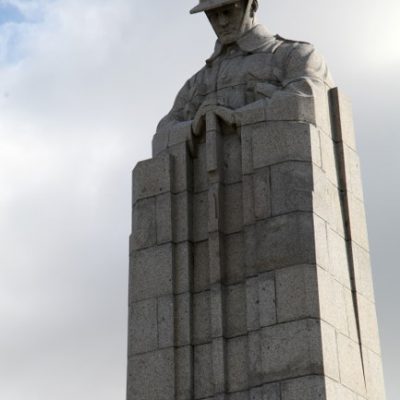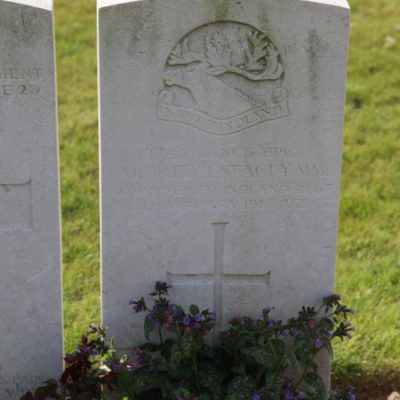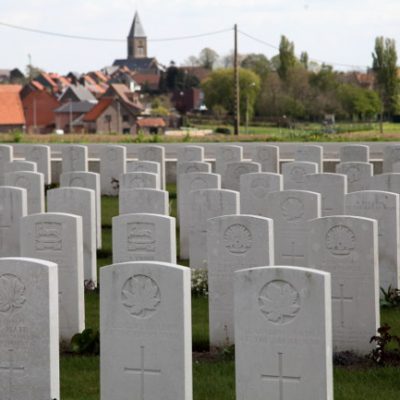The overwhelming thing about touring the countryside in Belgium and France is the sheer number of cemeteries in a relatively small amount of space.
Some are on the side of the road, some are hidden behind bushes and trees, and some quietly sit in the middle of farmland. I remember driving past one cemetery that was between a farmhouse and a barn… and it was surrounded by pigs and cows. It’s overwhelming to even think about it now… I can’t imagine living in a place that is filled with so much death and sacrifice.
All of the graves and memorials below were ones we stumbled upon during the drive between Ypres and Passchendaele. The distance between the two towns is a mere 18 kms… a muddy 18kms that was fought over for most of the war.
The Brooding Soldier
The Saint Julien Memorial (a Canadian memorial) looks solemnly downward toward the land where tens of thousands of Canadian soldiers fell during the Second Battle of Ypres… many from the first gas attack that Fritz Haber released onto the countryside. The impact of the gas was devastating and losses tremendous; humankind was deeply tarnished that day.
The bushes and vegetation around the memorial are shaped to mimic explosions and weaponry; some look like gas or are the colour of blood. For our visit, they were slightly overgrown (it was Spring after all) but the imagery was clear and poignant.
“It was in the Battle of St. Julian, the biggest battle in record, we had quite a lively old time I assure you and a large bunch went under. We had 640 casualties in our battalion… The huns used gases on us and a lot died with them, it was awful for awhile-three days- shells bursting all around and in the area in which we fought there is not 10 yards square that is clean of Jack Johnson holes. We taught the huns how Canadians can fight.” Letter written by Canadian Walter Thomas Robus on May 7th, 1915 after the Second Battle of Ypres.
St. Julien Dressing Station Cemetery
A dressing station in World War 1 was where wounded soldiers were evacuated during a battle. The St. Julien Dressing Station Cemetery is where many who died in the battle for the Ypres Salient are buried.
“…the worst in the whole firing line they are being killed & wounded all around it is awful to see the poor soldiers passing us on the road with the bandages in all sorts of places but mostly in the head…” Letter written by Canadian William John Howe on April 22nd, 1915 shortly before his is presumed to have been KIA during the Second Battle of Ypres.
The land the cemetery sits on was lost during the Second Battle of Ypres. Over the next few years, it passed back and forth between the two armies and officially became an Allied burial ground in 1917; it was heavily damaged during shelling in 1918 and later restored then expanded after the war.
There are 15 Canadians buried here; including members of Montreal’s Black Watch and soldiers from the Royal Newfoundland Regiment.
Dochy Farm New British Cemetery
On the way out of Zonnebeke and near the Belgian town of Poelkapelle, is a flat cemetery that sits on land that once held a German farm named “Dochy Farm” by British soldiers.
The land was held by German troops until 1917 when the 4th New Zealand Brigade took the region during the Battle of Broodseinde. This battle and the cemetery’s position close to Passchendaele makes it a popular destination for New Zealanders.
67% of the graves at Dochy Farm are unidentified and come from nearby battlefields in Boezinge, St. Julien, Frezenberg, and Passchendaele. 83 of these graves are Canadian (936 Brits, 305 Aussies, 98 New Zealanders, and 17 South Africans).
“Dozens got hung up in the wire and shot down before their surviving comrades’ eyes. It was now broad daylight and what was left of us realised that the day was lost. We accordingly lay down in shell holes or any cover we could get and waited. Any man who showed his head was immediately shot. They were marvellous shots those Huns… These chaps [Tommies], wounded in the defence of their country, had been callously left to die the most awful of deaths in the half frozen mud while tens of thousands of able bodied men were camped within five miles of them behind the lines.” Letter written by New Zealander Leonard Hart on October 19th, 1917 after the Battle of Broodseinde.
Cimetiére de Saint Charles de Potyze
The tiny little crosses at Cimetiére de Saint Charles de Potyze are so meticulously lined up that they create a depth optical illusion everywhere you look. We looked for crosses that were slightly out of place or not perfectly lined up… and could find nothing other than visual breaks caused by the graves of soldiers buried under non-cross gravestones.
After the war, French soldiers from all over the Belgian front were brought here and reburied. We immediately noticed that everyone interred here was identified. At first, we thought that either the French were really good at identifying the dead or soldiers carried a foolproof/bombproof means to identify. But, as it turns out, everyone in the cemetery is known because those who couldn’t be identified were moved to an ossuary in Le Mont-Kemmel or consolidated into one mass grave.
“Depuis quelques jours nous sommes toujours au même endroit. Hier nous avons passé une mauvaise journée, il n’a fait que pleuvoir. Mes hommes sont tout trempés. Aujourd’hui on dirait que cela va se tourner en neige. La pluie avait fondu l’ancienne neige, il n’y en avait que sur les hauteurs et ici où le vent en avait charrié. La température n’est pas trop froide. Je ne sais pas si je t’avais dit que j’étais en face un village. J’entends les cloches et les horloges. Avec mes jumelles je vois l’heure à l’horloge qui est au clocher. Je peux ainsi contrôler l’heure de ma montre.
Le service n’est pas facile la nuit. Dans ces pins c’est noir, il faut se diriger à tâtons. Aussi ceux qui vont chercher les aliments, ont une peine infinie à se retrouver. La soupe arrive froide.
Bien peu en mangent, et la plupart du temps ils la renversent en route en trébuchant. On languit d’être relevé. Cependant ici je n’ai pas souffert du froid.” From a letter written on April 8, 1915 by French soldier Reymond Molle to his wife Emma. On April 17th, 1915, Moole died at the Battle of Vosges.
Passchendaele
There are many cemeteries and memorials surrounding the town of Passchendaele. The war was long and particularly bloody in this part of Belgium (1914-1918). And, all allied troops suffered losses in an attempt to retake the town itself… Canada gave 16,000 lives during the capture of Passchendaele Ridge, many of whom were simply lost to the waist-deep mud.
Here we visited the Passchendaele New British Cemetery and Canadian Memorial. The New British Cemetery was created after the war by bringing in all the bodies found on the battlefields of Passchendaele and Langemarck. Many are unidentified.
By the end of the day, I couldn’t take any more death and as I gazed over the walls of the Passchendaele Cemetery onto the freshly turned farmer’s field I saw what looked like a piece of long-bone… twisted, without marrow, with a slight presence of osteo build-up due to muscle attachment… I’ve seen this before… a piece of bone that belongs close to the femoral head.
The horror of war is so deeply imprinted on this land that even 100-years later evidence is still spewing up to the surface.

































0 comments on “So many cemeteries… so much death…”Add yours →